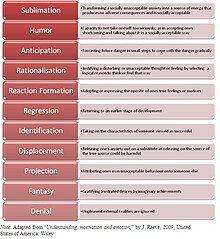Motivation and emotion/Book/2022/Sublimation
What is sublimation and how can it be fostered?
Overview
[edit | edit source]|
Example of sublimation: If a person was struggling with violent thoughts or urges, instead of being aggressive he instead decides to go for a run. |
Defence mechanisms are utilised by everybody. However, this book chapter focuses on sublimation as a coping mechanism and how it is fostered. Sublimation is when uncomfortable urges or feelings are transformed into more comfortable and non-threatening behaviours as an attempt to decrease distressing emotions (Wojda, 2022). Sublimation was first introduced within Sigmund Freud’s Psychoanalytic theory on personality, which breaks down the human brain into three components, the id, the ego, and the superego (Cherry, 2020). This chapter demonstrates how sublimation is fostered through these three components and, the benefits and costs of sublimation as a coping mechanism using peer-reviewed research.
|
Focus questions:
|
Sublimation
[edit | edit source]Sigmund Freud developed "sublimation" as a defence mechanism, which is used to channel unacceptable urges into ones that are helpful to the individual (Cherry, 2020).
Sublimation was developed after Freud read a book called "The Harz Journey", in which a boy named Johann Friedrich Dieffenback would cut off the tails of stray dogs and was labelled as cruel or sociopathic before growing into a successful and caring surgeon. Freud states that Dieffenback was able to transform his culturally unacceptable impulse into a more positively received and beneficial behaviour, whilst still satisfying these urges (Wojda, 2022).
Psychoanalytic theory
[edit | edit source]
Freud established the Psychoanalytical theory to analyse human beings as harbouring both conscious and unconscious thoughts, feelings and urges (Mcleod, 2019). Furthermore, Freud believed that gaining more insight into unconscious feelings will result in core internal conflicts or repressed emotions being resolved and released (Mcleod, 2019). However, as the unconscious mind is often inaccessible, psychologists who utilise the psychoanalytic approach often use tools like Rorschach inkblots, dream analysis, or childhood memories to gain further insight into the patient's unconscious (Mcleod, 2019).
Freud states there are three crucial components to the human brain. This includes the id, ego, and superego. In figure 1 attached to the right, it identifies where these concepts sit within our consciousness. The id is our instinctual basic impulse, the ego is a subconscious state of mind mediating between the id and superego, and the superego is mostly focused on displaying socially correct behaviours. This is important, as the first step to developing healthy behaviours is by recognising instinctual impulses and feelings within the id and employing the ego to cope with them in an emotionally mature fashion (Safran & Gardner-Schuster, 2016).
The id
[edit | edit source]Freud describes the id as an unconscious state of mind that is primitive and instinctual, in which its purpose is to fulfil every basic urge and wish despite cultural and social norms (Mcleod, 2022). The ID often contains impulses that can be considered socially unacceptable such as sexual or aggressive urges. This is due to the ID being driven by the ‘Pleasure principle'. The pleasure principle is defined as the motivating factor that strives for instantaneous reward, to further elaborate this principle is responsible for fulfilling our basic needs such as thirst, hunger, frustration, and sex (Cherry, 2020). However, if one were to consistently act accordingly with the pleasure principle, socially inappropriate behaviours are encouraged, resulting in further distress or anxiety on ourselves.
The ego
[edit | edit source]If we were to consistently act within the wishes of the ID we would be ensuring increased distress within ourselves. Therefore, this is when the ego is the most crucial as the ego implements rational and developed tools to satisfy our urges while still meeting social and cultural standards (Mcleod, 2022). This is due to the ego operating within the ‘realistic principle’ framework, this principle aims to fulfil our basic urges in a socially acceptable way, although usually minimizing satisfaction to avoid negative interactions from society (Mcleod, 2022). The ego is capable of thinking more maturely due to lying within the subconscious component of the human brain, which means it is able to act accordingly within reality, despite the ID living within fantasy. However, if the ego were to fail to act within the realistic principle framework, the unconscious would employ defence mechanisms to cope with increased distress or anxiety (Mcleod, 2022).
The superego
[edit | edit source]The superego is the most impacted by cultural and social norms and strives to control the ID’s urges in pursuit to become their ‘ideal self’ (Mcleod, 2022). The ‘ideal self’ is concerned with integrating peacefully with society and fulfilling career goals. In conjunction with that, the superego is focused on behaving morally ‘right’ and if we act accordingly results in pleasure through the ideal self, if we do not act in a morally ‘right’ manner, self–criticism will be triggered, resulting in increased guilt. It’s important to note if the superego is enduring guilt, unconscious defence mechanisms will be implemented (Mcleod, 2022).
How is sublimation fostered?
[edit | edit source]As sublimation is often a defence mechanism that is operated unconsciously, individuals may already be fostering sublimation without realising it (Shah, 2022). Defence mechanisms are fostered when a person has an unacceptable urge that they are seeking out. The ego will encourage sublimation to transform these urges into more acceptable ones in order to alleviate the person's distress or anxiety (Shah, 2022). To summarise, when a person has inappropriate urges or thoughts usually originating from the id, the superego will implement shame or anxiety to deal with the uncomfortable thought. As the individual is experiencing distress, the ego will foster sublimation to remove the distressing symptoms and transform any uncomfortable urges (Mcleod, 2022).
| Case study:
Meet Alex. Alex is frustrated with his partner because she is constantly leaving dishes in the sink. Alex has the urge to yell and start an argument with his partner about the issue, as he is irritated. However, he instead decides to punch a punching bag until he has calmed down. |

Benefits and costs
[edit | edit source]Sublimation is listed as a ‘High-adaptive’ defence mechanism and is widely known as one of the more ‘mature’ coping mechanisms as it encourages individuals to channel distressing symptoms into more positive behaviours, rather than act on maladaptive impulses (Di Giuseppe & Perry, 2021). In fact, a study conducted in 2018 on defence mechanisms utilised in cancer patients, found that individuals who implemented ‘High adaptive’ defence mechanisms resulted in higher physical and emotional functioning (Di Giuseppe et al., 2018). A higher survival rate also correlated with high adaptive defence mechanisms as it enabled the patient to transform uncomfortable feelings into less-distressing ones (Di Giuseppe et al., 2018). Another study conducted in 2021 on defence mechanisms during the COVID-19 pandemic stated that sublimation was the more beneficial coping mechanism throughout the pandemic and was utilised frequently for staff members still having to work throughout the pandemic (Walker & McCabe, 2021) As staff members were getting frustrated about having to work overtime more frequently, instead of getting more agitated, sublimation was fostered and they developed a rota to develop a new plan for all staff to collect extra shifts (Walker & McCabe, 2021).
However, I think the benefits of sublimation are best contextualised when considering the research conducted in 2016, which compared different coping mechanisms for inmates who are enduring the struggles of long life sentences (Wright et al., 2016). Throughout this study, coping mechanisms such as suppression, denial, and sublimation are compared to evaluate the benefits and costs. It was apparent that sublimation was the most beneficial and was identified as ‘Crucial’ for early years of imprisonment (Wright et al., 2016). A total of 146 inmates were interviewed during different stages of their prison sentence, early - less than four years severed, mid - mid point of sentence and, late - sentence end date, minus two years(Wright et al., 2016). The inmates were asked about problems faced inside prison and their well-being. It was found that inmates who used sublimation channelled their negative impulses into artistic or intellectual means, one inmate named 'Asad' who is mid way through his sentence, stated that sublimation was a way of giving himself "hope" (Wright et al., 2016).
However, as sublimation is often a helpful coping mechanism, it also may inhibit self-awareness (Shah, 2022). As sublimation operates within the unconscious, individuals may not be aware they are sublimating. As defence mechanisms are triggered when distressing thoughts arise, individuals may not want to confront these distressing thoughts and feelings (Shah, 2022).
Therefore, sublimation enables individuals to transform threatening impulses or thoughts into more comforting or beneficial behaviours, reducing the distressing symptoms surrounding unacceptable urges or feelings. However, as it may reduce anxiety, it does not increase self-awareness and may hinder self-reflection.
Conclusion
[edit | edit source]Sublimation was identified as a defence mechanism by Freud, after reading about a surgeon who cut off the tails of stray dogs but changed these impermissible urges into more acceptable behaviour. Sublimation, as defined by Freud, is the belief that socially unacceptable emotions can be changed into less dangerous, more advantageous behaviours. This part of the human psyche, known as id, is where these undesirable drives, emotions, and thoughts reside. If the id succeeds in fulfilling these basic inappropriate urges, the ego will foster sublimation to deal with the distressing symptoms of these thoughts or urges. One of the most efficient and adaptable coping techniques is sublimation, however it's crucial for the person who is sublimating to face the underlying causes of their behaviour.
See also
[edit | edit source]- Anorexia nervosa and extrinsic motivation (Book chapter, 2016)
- David McClelland (Wikipedia)
- Loss aversion (Book chapter, 2018)
- Maslow's hierarchy of needs (Wikipedia)
- Defense mechanisms (Book chapter, 2015) (Book chapter, 2015)
References
[edit | edit source]Di Giuseppe, M., & Perry, J. (2021). The Hierarchy of Defense Mechanisms: Assessing Defensive Functioning With the Defense Mechanisms Rating Scales Q-Sort. Frontiers In Psychology, 12. https://doi.org/10.3389/fpsyg.2021.718440
Di Giuseppe, M., Ciacchini, R., Micheloni, T., Bertolucci, I., Marchi, L., & Conversano, C. (2018). Defense mechanisms in cancer patients: a systematic review. Journal Of Psychosomatic Research, 115, 76-86. https://doi.org/10.1016/j.jpsychores.2018.10.016
Mcleod, S. (2019). Simplypsychology.org. https://www.simplypsychology.org/psychoanalysis.html.
Mcleod, S. (2022). Id, Ego, & Superego
External links
[edit | edit source]- Freud on: Sublimation (You tube video)
- Psychoanalytic theory
